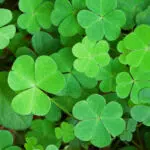Known as the official holiday of Cornwall, St. Piran’s Day honors the patron saint of tin miners on March 5, an important industry in the region. Cornwall is in the southwesternmost peninsula in England and the homeland of the Cornish people. With a unique culture and language, Cornwall retains a strong sense of identity. St. Piran’s Day honors the legend of the saint who, after being thrown into the sea in Ireland, miraculously drifted ashore in Cornwall and blessed the local miners with the secrets of tin extraction. The holiday is celebrated with parades, re-enactments, and parties.
History of St. Piran’s Day
On March 5, Cornwall celebrates St. Piran’s Day, its most important holiday. St. Piran is the patron saint of tin miners, an industry that was the keystone of Cornwall’s economy for centuries.
Although much of his life is shrouded in mystery, historians believe that St. Piran was a 5th-century bishop exiled from Ireland. When he was thrown into the sea to drown, he miraculously came ashore on Cornwall’s Perran Beach. There, the saint built a small chapel whose remains can still be observed today.
St. Piran is known for discovering the process of tin extraction, giving local miners the secrets of Cornwall’s most important industry. He noticed a black stone leaking a white liquid when heated up by his fire — and tin mining in Cornwall was born. The Cornish flag, a white cross on a black background, represents this crucial revelation. Tin mining changed the economy of Cornwall and remained at the heart of its economy until the last mine shut down in 1998.
The holiday gained new popularity in the early 20th century as Celtic revivalists looked for ways to strengthen local pride. The holiday has been observed in almost all Cornish towns since the 1950s, complete with parades and public celebrations. The distinctive black and white flag can be seen flying across Cornwall in early March.
Customs associated with the holiday include re-enactments of St. Piran’s life, live music, and the consumption of traditional Cornish foods and copious amounts of alcohol.
St. Piran’s Day timeline
According to legend, after the Irish king orders St. Piran to be tied to a millstone and thrown into the sea, he miraculously survives, reaching the shores of Cornwall — there, he begins preaching Christianity and sharing the secrets of tin extraction with local miners.
Though little is known about his life, it’s believed that St. Piran dies in the year 480 — his relics are subsequently distributed to various churches.
The black and white flag representing St. Piran's discovery of tin is first adopted as the Cornish flag; it was officially made Cornwall's flag in 1890.
After 400 years of operation, Europe's last tin mine shuts down, officially ending this centuries-old Cornish industry.
St. Piran’s Day FAQs
What is St. Piran known for?
St. Piran, the patron saint of Cornwall’s tin miners, is known for discovering tin extraction and passing on its secrets to local miners, kickstarting the local mining industry.
How do you say Happy St. Piran's Day in Cornish?
In the Cornish language, “Happy St. Piran’s Day” is “Gool Peran Lowen.”
Is Cornwall part of England?
Cornwall is an administrative hub of England. Although it has its own culture, language, and flag, modern Cornwall is now part of England’s southwesternmost peninsula.
St. Piran’s Day Activities
Attend a St. Piran's Day parade
If you live in Cornwall, you’re likely to have a parade going on in your town on March 5. Find your local parade and immerse yourself in this unique regional celebration.
Learn some Cornish history
With its strategic location, ample coastline, and natural resources, Cornwall plays an important role in British and European history. Take some time today to learn a little about this fascinating place.
Eat a Cornish pasty
The region’s most famous food, the Cornish pasty is a baked meat-filled pie that you can sometimes find at restaurants outside the U.K. The traditional pasty is stuffed with beef, potato, turnip, and onion.
5 Interesting Facts About St. Piran’s Day
Cornwall has its own language
The Cornish language, also known as Kernewek, is a Celtic language that's experiencing a modern revival — today, Cornish children learn Kernewek in school, ensuring the language will be passed on to the next generation.
One of the first steam engines invented in Cornwall
Richard Trevithick created a steam engine that used high-pressure steam to pump water from mines — this new device made mining easier and circumvented the other patent-protected technologies available at the time.
The Cornish didn't just mine tin
In the early 19th century, Cornwall produced two-thirds of the world's supply of copper.
No crusts
Miners enjoyed Cornish pasties as a hearty snack during their long workdays, but they wouldn't eat the crust, not because they were picky, but because of the poisonous chemicals on their hands — by holding the pie by the crust and throwing the crust away, they avoided ingesting dangerous substances.
Surf's up
Surfing may not be the first sport that comes to mind when you think of Great Britain, but Cornwall's shores might surprise you — winter waves can reach as high as 30 feet!
Why We Love St. Piran’s Day
It teaches us about a new place
If you’ve never thought about Cornish history, now’s your chance to educate yourself about this small but important English town.
It’s an excuse to party
St. Piran’s Day is known as a day of parades, fun, and debauchery. If you get the day off, celebrate by spending time with your family and friends and enjoying a fun St. Piran’s Day activity.
It gives us a chance to try great food
Cornwall is famous for its pasties, but there’s a lot more to Cornish cuisine. On St. Piran’s Day, try some Cornish foods like clotted cream, stargazy pie, or pilchards.
St. Piran’s Day dates
| Year | Date | Day |
|---|---|---|
| 2025 | March 5 | Wednesday |
| 2026 | March 5 | Thursday |
| 2027 | March 5 | Friday |
| 2028 | March 5 | Sunday |
| 2029 | March 5 | Monday |























